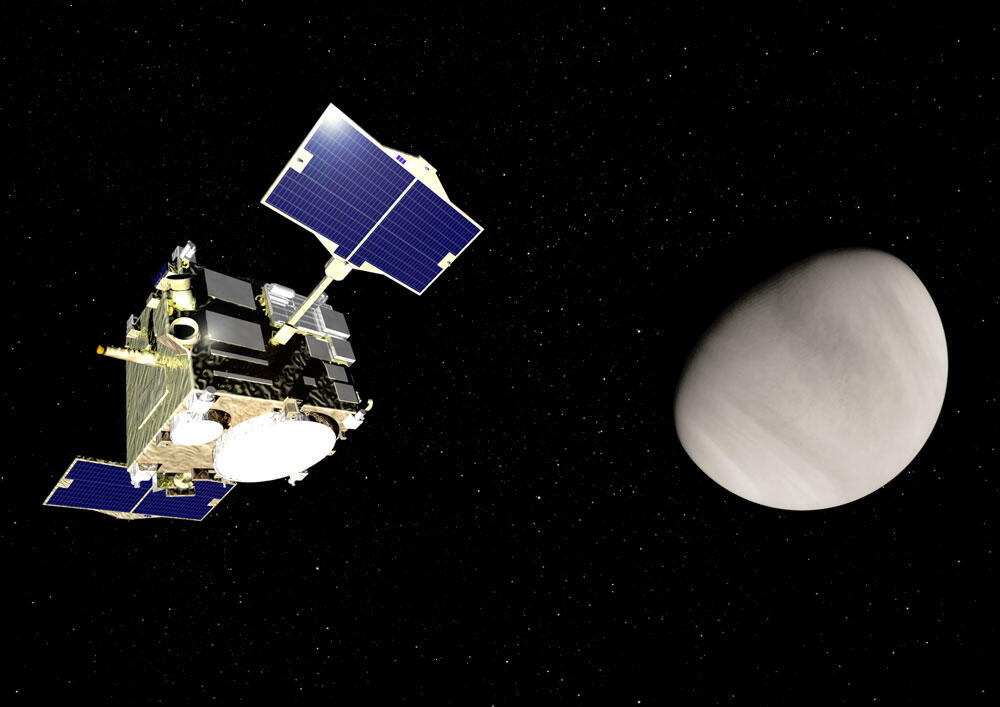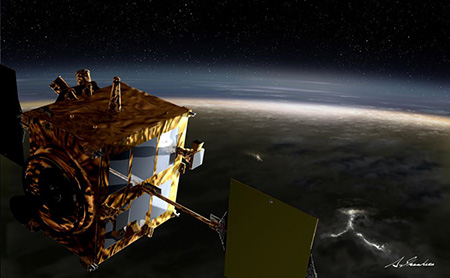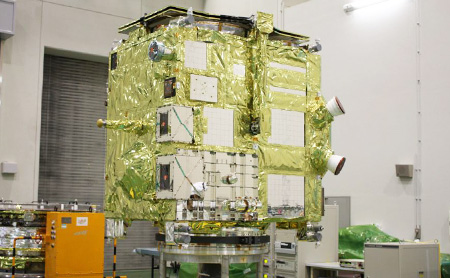About Venus Climate Orbiter "AKATSUKI" (PLANET-C)

|
AKATSUKI, which was launched in May 2010, was developed to solve the mysteries of the atmosphere on Venus. It is equipped with five cameras to photograph the Venusian atmosphere using infrared, visible light, and ultraviolet rays, and also uses other instruments to measure the altitudinal distribution of temperatures and other factors. These data will be used to study the flow and composition of the atmosphere, as well as the existence of lightning and volcanic activities. A number of discoveries have already been made and released using the data acquired from AKATSUKI. This includes the world’s first acquisition of the altitudinal temperature distribution between the altitudes of 40 and 85 kilometers for the entire planet of Venus, which was studied by a research team at Kyoto Sangyo University. Another discovery was on the long-abiding mystery regarding how the super rotation of Venus’ atmosphere was being maintained, which was uncovered by a research team comprised of JAXA, Hokkaido University, the University of Tokyo, and Rikkyo University. Launch date: May 21, 2010 |
|---|
Project Topics
indexVenus: Jet-setting atmosphere

|
Data from JAXA's Venus Climate Orbiter Akatsuki reports the evidence of a fast atmospheric flow near the planet's equator. JAXA and the team of researchers from the Hokkaido University and others used images from the Akatsuki orbiter to track jet*-shaping strong winds in the low and middle cloud region, which extends from 45 to 60 kilometers in altitude. The wind speed maximized near the equator. They named this phenomenon Venusian equatorial jet. Previously, the wind speed at this altitude w...
|
|---|
Press Release
index-
- Sep. 18, 2025 (14:00) [release]
- Venus Climate Orbiter “AKATSUKI” Operation Completed
-
- Jul. 22, 2021 (12:30) [release]
- New observations from the Venus Climate Orbiter, Akatsuki, published in Nature
Re-execution of Venus orbit insertion and successful result
|
The AKATSUKI was launched by the H-IIA Launch Vehicle No. 17 in May 2010. After its smooth flight, JAXA
attempted to insert the orbiter into the orbit circling around Venus on Dec. 7, 2010, but it failed as the
main engine for orbit control was broken. |

|
|---|
Characteristics of Venus Climate Orbiter "AKATSUKI" (PLANET-C)
Infrared light enables more detailed investigation of Venus.
|
The probe vehicle of AKATSUKI will enter an elliptical orbit, 300 to 80,000 km away from Venus’s surface. This wide variation in distance will enable comprehensive observations of the planet’s meteorological phenomena and of its surface, as well as observations of the atmospheric particles escaping from Venus into space. It will also be possible to take close-up photos of Venus, and to observe the storm winds that blow on the Venusian surface, at speeds that reach 100 m a second - 60 times the speed at which Venus rotates. This phenomenon remains the biggest mystery of Venus, as it cannot be explained meteorologically. AKATSUKI will employ infrared light to observe and elucidate the mysteries surrounding the atmosphere under the clouds and the conditions on the planet’s surface. In addition, it will confirm the presence of active volcanoes and thunder. |

|
|---|
Major Characteristics
| International Designation Code | 2010-020D |
|---|---|
| Launch Date | 6:58, May 21, 2010 (JST) |
| Launch Vehicle | H-IIA Launch Vehicle No.17 |
| Location | Tanegashima Space Center |
| Shape | Box shape with two wing-type solar array paddles |
| Weight | Mass at liftoff: about 500 kg |
| Orbital Altitude | PeriVenus: 1,000-10,000km ApoVenus: 370,000km |
| Type of Orbit | Elliptical around Venus |
| Orbital Period | 10.8 days |
Mission talk by team leaders

|
Project manager Masato NakamuraHere are messages from Project Managers. |
|---|

